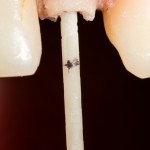
The restoration of root treated teeth may require the use of post-and core techniques. In recent years fibre-reinforced composite posts have emerged as an alternative to traditional cast or prefabricated metal posts. One important factor in increasing fracture resistance is considered to be the presence of at least 2 mm of dentine in the coronal portion which is known as the ‘ferrule effect’.
The aim of this review was to evaluate whether the presence or absence of a ferrule influences the failure rate in fibre-reinforced composite (FRC) post-and-core restorations.
Methods
Searches were conducted in the PubMed/ Medline, Embase, Scopus, and Cochrane Library databases supplements by searched in the journals; Journal of Dentistry, Dental Materials, Journal of Prosthetic Dentistry, Journal of Oral Rehabilitation, Journal of Prosthodontics, International Journal of Prosthodontics, American Journal of Dentistry, Journal of Endodontics, and International Endodontic Journal. Randomised clinical trials (RCTs), prospective clinical trials or prospective randomised studies comparing the rehabilitation of teeth with and without remaining dentin (ferrule), with a minimum of 10 participants in each group follow-up of longer than 6 months and published in English were considered.
Two researches independently conducted the search, selected studies and extracted data with study quality being assessed with the Jadad scale. Decementation, post fracture, root fracture, coronary portion fracture, endodontic failure, and crown displacement were considered general failures and evaluated as a dichotomous outcome. Relative risk (RR) and 95% confidence interval (CI) were calculated and random effects meta-analyses conducted.
Results
- 4 studies (3 RCTs, 1 prospective study) evaluating 297 teeth (157 with ferrule, 140 without) were included.
- Follow up peris ranged from 36-72 months (mean = 45 months).
- Survival rate varied from 72.5% to 95% in the ferrule groups (mean 88.35%) and from 62.5% to 95.2% in the non-ferrule group (mean 78.05%)
- Meta-analysis (4 studies) showed no statistically significant difference for general failure between ferrule and non-ferrule groups. RR = 0.71 (95%CI; 0.47 to 1.06).
- Meta-analysis (2 studies) showed no statistically significant difference for post or root fracture: –
- Post fracture RR = 0.65 (95%CI; 0.21 to 1.94).
- Root fracture RR = 0.42 (95%CI; 0.03 to 5.15).
Conclusions
The authors concluded: –
The ferrule effect does not appear to reduce the failure rate of FRC post-and-core restorations significantly when compared with its absence.
Comments
We have previously looked at a review assessing the influence of the number of remaining coronal walls, the use or not of posts, (Dental Elf – 20th Feb 2017) this new review has a narrower focus. A good range of databases has been searched but restricting inclusions to English language publication may result in excluding relevant publications. The authors have used the Jadad scale to assess study quality, this method is no longer recommended. The Cochrane risk of bias tool for RCTs and the ROBIN-I tool for non-randomised studies would have been more appropriate. (https://www.riskofbias.info/) Only one of the 4 included studies scored well in the Jadad scale so the quality of the available evidence is low and should be taken into consideration when assessing the findings. The studies included a variety of restorations mainly in the premolars including metal-ceramic and metal- free prostheses, both complete- and partial-coverage restorations. While the findings suggest no differences between the failure rates between ferrule and no ferrule restoration additional high quality well reported studies are needed to provide better quality data.
Links
Primary Paper
Batista VES, Bitencourt SB, Bastos NA, Pellizzer EP, Goiato MC, Dos Santos DM. Influence of the ferrule effect on the failure of fiber-reinforced composite post-and-core restorations: A systematic review and meta-analysis. J Prosthet Dent. 2019 Jun 18. pii: S0022-3913(19)30079-4. doi:10.1016/j.prosdent.2019.01.004. [Epub ahead of print] Review. PubMed PMID:31227236.
Other references
Dental Elf – 20th Feb 2017
Post-retained single crowns performance linked to amount of coronal structure
